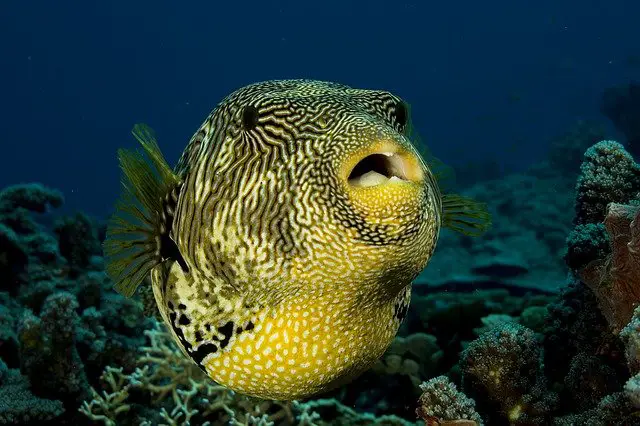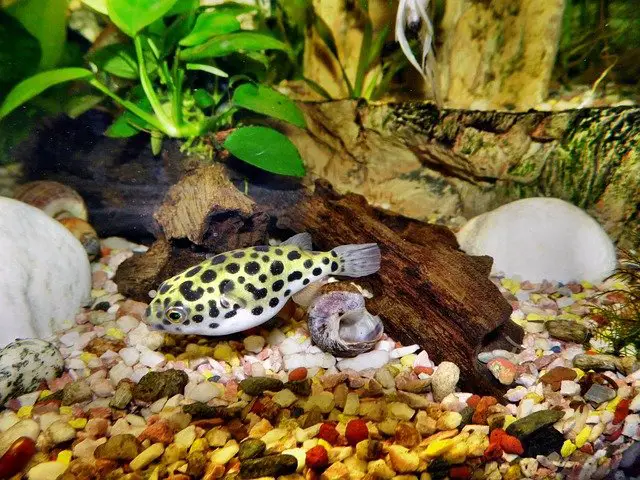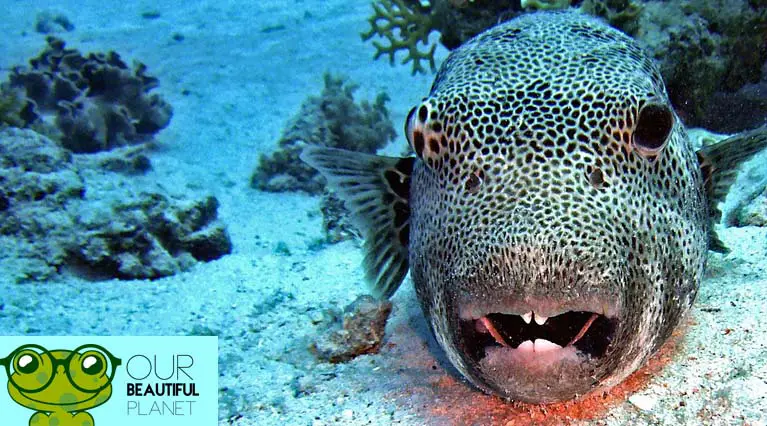Last modified on February 22nd, 2021 at 7:19 am
Puffer Fish Facts You (Probably) Didn’t Know
One of the most widely recognized species of fish in the world is the puffer fish. With its comically round body, and exuberant coloring, the cute puffer fish is a favorite amongst divers, and is quickly becoming a favorite of fish owners as well.
Commonly known as the Globe Fish, Blowfish, Balloon Fish and Fugu in Japan, there are more than 120 known puffer fish species found worldwide today.
One of the most recently discovered species, the White Spotted Puffer Fish, resides in the ocean surrounding Japan. The White Spotted Puffer Fish was discovered when scientist noticed strange circular patterns appearing on the sea bed. These strange patterns, which led to the White Spotted Puffer Fish’s discovery were found to be used to attract a mate during mating season.
Puffer fish defenses
Since they are not the fastest fish in the sea, and bright colorations don’t do much in the ways of camouflage out in the open water, the puffer fish developed a strategy to make themselves appear larger to intimidate predators.
Puffer fish inhale air to turn into a spherical version of themselves, often times complete with poisonous spikes to detour any larger predator that might want to turn them into a quick meal. Puffer fish also have incredibly thick skin, which makes it hard for any resilient predator to even try take a bite out them. You can learn more interesting facts on FactRetriever.

For years, it was believed that puffer fish pull oxygen from the water through their gills to ‘puff up’ and hold their breath to maintain that appearance. However, recent research done by Australian Marine Biologists discovered that puffer fish continue to breathe in this defensive state. This research also found that puffer fish take in air through their skin. This can put a great deal of stress on the puffer fish’s body. It can take up to five hours and thirty-six minutes for puffer fish’s metabolism to return to normal.
Puffer fish poison: Tetrodotoxin
Though puffer fish may not look intimidating, they are actually one of the most poisonous species on the planet. Puffer fish have a deadly poison called Tetrodotoxin (TXX) which is 1,200 times more deadly than cyanide. Their toxin is so potent, one puffer fish contains enough Tetrodotoxin to kill thirty adult men.
While this toxin Is extremely dangerous to humans, it is not as dangerous to other animals. It was recently observed that dolphins have found a way to get high off tetrodotoxin by chewing on a piece of puffer fish. Tetrodotoxin in small doses produces a narcotic-like effect for the dolphins.
Levels of this toxin can vary from species to species. Those free of tetrodotoxin in their system tend to become a meal for larger carnivorous fish.
Some scientists argue that puffer fish are not born poisonous, but rather that it is a developed trait. They hypothesize that the bacteria ingested from their prey causes a chemical reaction leading to the development of the toxic. This is a highly probable theory considering that puffer fish kept as pets and on differing diets than their oceanic counterparts, tend to have a very low amount of toxins in their body.
Where do puffer fish live?
Puffer fish are most commonly found in tropical and subtropical waters. The majority of puffer fish can be found in coastal regions in the Indian, Atlantic and Pacific Oceans. However, there are some species who thrive in freshwater, and brackish water environments. Some species also reside in the coasts off of Australia and the Amazon River of South America. The various species can vary in size from one inch to the 47-inch Stellate puffer fish found in the waters of Africa and Japan.
Types of puffer fish:
Freshwater puffer fish:
Out of the 120 species of puffer fish, only 29 of those are truly native to freshwater. About 40 species can survive in a brackish water environment. Among the freshwater species are the dwarf Puffer Fish, the Giant Freshwater Puffer fish, which can grow up to 2 feet long, native to Africa, the Bronze Puffer Fish found in the waters of Asia, The Red Tailed Red Eye Puffer of Asia, The South American Puffer Fish of the Amazon, and the Fang’s Puffer Fish which can be found in Mekong River located in Asia.
Dwarf/pygmy puffer fish

The Dwarf, or Pygmy Puffer Fish is the smallest out of all the species, only growing to be about one inch in length. As a species that thrives in a freshwater environment, these small puffers can be found swimming in the Pamba River in India. The small fish have become a popular species to add to aquarium enthusiast’s collection, as they can thrive in freshwater and have seen to exhibit entertaining and intelligent personalities.
The Dwarf Puffer Fish are not born any certain sex, as they mature, this puffer fish can choose whether it wants to be male or female, and if a fish decides it wants to be male, it will secrete a hormone to let any other fish in the area to know to become female, as to remain the alpha male. This behavior is known as sexual dimorphism.
Spotted puffer fish
The Green Spotted Puffer fish can live in both Brackish and freshwater environments. Commonly found in the waters of South and Southeast Asia, the Spotted Puffer Fish is a one of the smaller species, growing only up to about 6 inches long.
With its playful, friendly demeanor, and adorable bug eyed smiling appearance, this species is gaining in popularity as a pet. It can survive in Freshwater tanks during its juvenile stage but as it matures, moving to Brackish or salt water is best for this species. In the wild, these fish migrate from salt water to brackish water basins to mate and lay their eggs.
What do puffer fish eat?
Puffer fish have a varied diet, but have been observed to be mostly carnivorous. Though they may eat algae and other aquatic plants for convenience, they prefer shellfish such as mollusks, clams and even crabs.
The puffer fish are able to eat the hard-shelled prey due to a beak like formation of four teeth that develop. They use these tough ‘beaks’ to break open the shells, and kill if necessary to get to their food source.
Puffer fish have been found to hunt their prey in three distinct methods. The first method is stealth, sneaking up on their unsuspecting prey then striking. The second method is Ambush. The process involves waiting patiently in a hidden area for prey to get close. The third method is open water hunting. This is a more offensive method which involves swimming in the open to find food.
Below is a video of a puffer fish eating a crayfish to display the ambush method of hunting the species uses.
With a background in business and Wildlife ecology I have been a nature enthusiast all my life. If I’m not writing, I can be found buying too many books, hiking, or cuddling my pet Degu.




